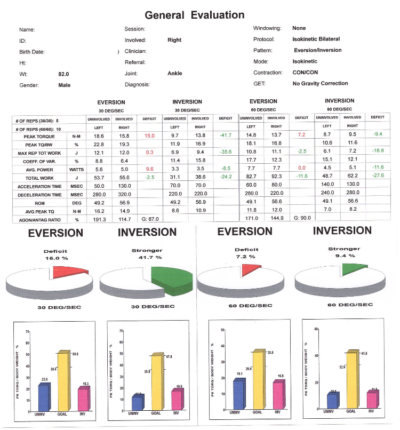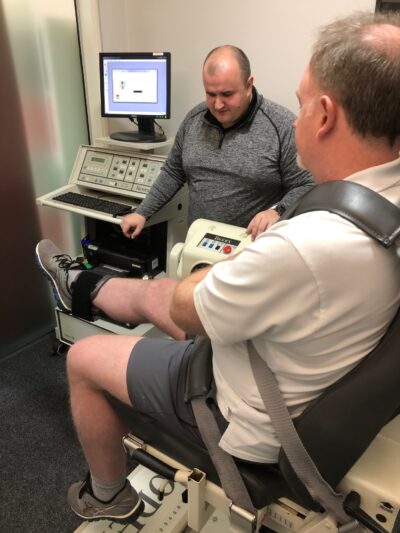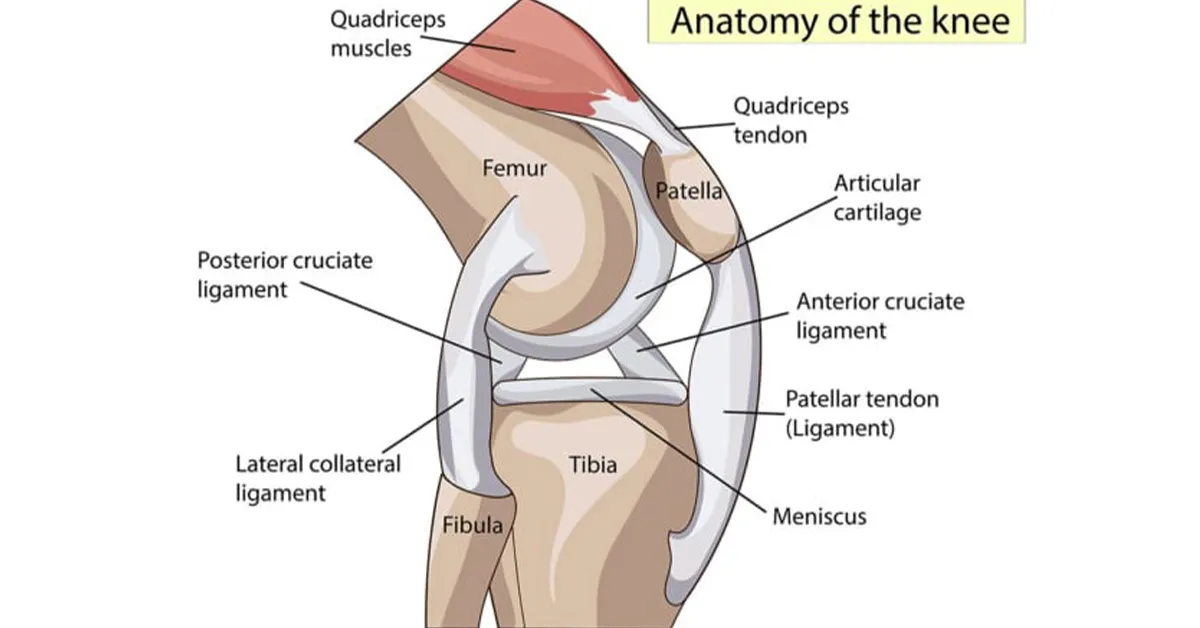What is the Biodex?
Isokinetic refers to a type of assessment or training used in sports medicine, rehabilitation, and exercise science. Biodex is the brand of a type of isokinetic dynamometer – basically a great piece of kit that can be used in the treatment of most areas of the body. Testing involves measuring muscle strength and performance at a constant speed of movement, allowing for controlled resistance throughout the range of motion. Although developed for sports, it is really helpful in the assessment and rehabilitation of all ages and abilities. Isokinetic testing offers several benefits, including:
- Objective measurement: Isokinetic testing provides objective and quantitative data on muscle strength, power, and endurance. It allows for accurate and reliable measurement of force production and muscle performance, providing valuable information for assessment and monitoring progress over time. Muscle weakness can be an important factor to be addressed in the management of sports injuries, tendon pathologies, and joint problems such as instabilities and arthritis. Accurate information helps guide treatment decisions.
- Comprehensive assessment: Isokinetic testing can evaluate various aspects of muscle function, including peak torque (maximum force output), total work (amount of force exerted over a range of motion), and muscle imbalances (strength disparities between opposing muscle groups). It helps identify specific areas of weakness or asymmetry, enabling targeted interventions and rehabilitation programs.

- Rehabilitation guidance: Isokinetic testing is commonly used in rehabilitation settings to assess individuals recovering from musculoskeletal injuries or surgeries. By quantifying muscle strength deficits and imbalances, it assists in designing customized rehabilitation protocols and monitoring progress throughout the recovery process. It allows clinicians to set appropriate goals and make informed decisions regarding exercise progression.
- Injury prevention: Isokinetic testing can be utilized as a pre-screening tool to identify individuals at risk of injury. By assessing muscle imbalances, functional deficits, and weaknesses, it helps identify areas of vulnerability. This information can then be used to develop targeted training programs aimed at improving strength, stability, and reducing the risk of future injuries.
Used for optimal training too
As well as testing, the Biodex can be used in ongoing rehabilitation. Because the Biodex moves at a constant speed that you cannot change regardless of how hard you push, it has the unique capability in being able to get the best strengthening effect within a session. Every repetition undertaken can be performed at the maximum output. This means you are working the specific muscle to its maximum. Having said this, it is also very useful at the early stages of rehab, where we can set it so you are pushing only to a level that doesn’t cause pain, or there are passive modes where the machine moves for you. This can be used to stretch joints that are restricted. The risks of flare up are reduced due to its versatility.
Training on the Biodex, therefore can give your rehab a huge boost. If you have identified a muscle group that is weak and a major contributor to your problem, a strength based programme will be a component of your rehab. In a training session with the Biodex, you can push yourself to the limit without fear of injury (under the guidance of your physio of course), which means that your home or gym sessions for the rest of the week will be more effective and your return to normal function quicker.
Conditions commonly seen for Biodex
The Biodex can be used to assess and train muscle function in the following conditions:
ACL tears / Anterior Cruciate ligament reconstruction – It can be used to monitor progress in quadriceps and hamstring muscle strength post injury or post-op and to guide return to running and return to sport. Having concrete data that gives information on how your operated side compares to the good leg and how your leg strength compares to expected strength for your weight is invaluable in predicting your ability to return to sport without causing regression or flare ups. The hamstring is often used to provide the graft for the surgery, so ensuring this has been built back up to a level that is able to provide support to the graft is critical. Equally, patella tendon grafts post surgery can find it difficult to load the quads. Isokinetic allows huge versatility in being able to load the quads, without stressing the graft.
Unfortunately 34% of reconstruction surgeries do fail. This can be due to various factors, but one of them can be quadriceps weakness. A return to activity without adequate quads strength drastically increases the risk of re-injury. It is recommended that a Biodex assessment is conducted on every ACLR reconstruction or conservatively managed patient before they return to sport.

Meniscal tears (Non-obstructive) – Quads and hamstring strength can be affected due to periods of swelling and muscle inhibition. Improving strength to a level that allows the safe return to running, jumping and change of direction is essential to prevent further irritation of the meniscus. Assessments will demonstrate if you are ready to return to these activities. Training on the Biodex gives the ability to maximally load the quads and hamstrings without any compressive force going through the meniscus.
Ankle instabilities / reconstruction – when you go over on your ankle, the swelling in the joint will cause the lateral muscles to weaken. Rehabilitation of these muscles through strength training is essential to protect you ankle in the event that you twist your ankle again. This is a common position for the ankle to go into and it relies on the perineal muscles on the outside of the shin to pull your ankle back into position. The Biodex can be used to assess the strength status of the lateral muscles or be used to rehabilitate them with a weekly boost to your rehab programme.
Tendonopathies – slow heavy resistance is used in the treatment of tendon problems. The Biodex is able to load your tendons in ways you just can’t do in the gym. If you have a particularly problematic tendon issue, using the Biodex, coupled with the shockwave might be the combined treatment that you need, or simply loading the tendon on the Biodex 1-2x per week
Osteoarthritis – Getting the joint moving, graded loading and then building muscle strength around the joint is the best form of conservative management for osteoarthritis. You can do this in lots of different ways. Assessing how you are doing with your strength is most easily and safely done with the Biodex. If you are struggling to make the gains, doing a booster on a weekly basis, supplemented by your home or gym rehab might push you that bit harder and get better results.
Shoulder instability / Rotator cuff tears – you need good strength, whether you are recovering from a joint subluxation or dislocation to a small cuff tear or and impingement problem. All these conditions need good cuff strength, which is really difficult to measure properly. The Biodex is great at picking up and quantifying the deficit. Again weekly challenging sessions are also a brilliant way of boosting your rehab that you are doing at home or in the gym.
Muscle tears – for those really stubborn muscle tears, that keep occurring – eg hamstring tears, loading the muscle up to its peak performance can create resilience in the muscle protecting it from re-injury. If you have done this in the gym and it still is not working for you, and assessment first, then a programme of pushing the muscle should sort things out.
Other areas – the Biodex has a limited role in the treatment of spinal problems, but it can be used to grade loading of most peripheral joints or muscle regions.
How do you get an assessment?
Physis is one of only a couple of clinics in Edinburgh that has their own Biodex units, ours is located at the Mayfield clinic, and have several options open to you to suit your situation.
- We are happy to take referrals from other physiotherapist and health professionals to provide assessments for their patients. We can perform a one-off isokinetic assessment and provide you with an appraisal of the information to take back to your treating clinician.
- We are also, obviously happy to see you without a referral. Like all our services, you don’t need a referral for a Biodex assessment. Just let us know what your problem is and we will get you booked in.
- If you are in treatment, either within physis, or at another clinic, or managing your own rehab, we can also provide additional strength boosters for the rehabilitation of most areas of the body.
- Or you can commit to a course of isokinetic sessions (2 per week) over a period of 6-8 weeks (or what ever you choose).
If you are interested and want more information about this service or any or the services we provide at our Edinburgh Physiotherapy Clinics, please email us at [email protected] with any questions, or book an appointment.


